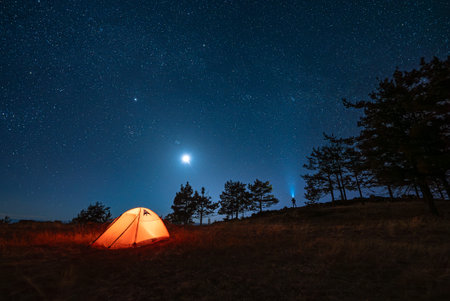Choosing the Perfect Campsite
If you want to camp comfortably without breaking the bank or hauling a car full of gear, the first thing to get right is your campsite. Picking the right spot can make all the difference between a stressful night and a cozy retreat. In the U.S., there are countless ways to find an affordable, scenic place to pitch your tent—if you know where to look.
Public Lands: Your Budget-Friendly Backdrop
Public lands are a camper’s best friend. National forests and Bureau of Land Management (BLM) areas offer dispersed camping, often free or for a minimal fee. These spots usually mean fewer amenities but more privacy and a genuine connection with nature. Always double-check local regulations, as some sites require permits or have fire restrictions.
National Parks: Comfort Meets Adventure
America’s national parks are iconic for a reason. While campgrounds inside parks can book up fast and sometimes cost more than public lands, they’re still budget-friendly compared to hotels or glamping resorts. Book early online—especially during peak season—and consider less-trafficked parks for better availability and lower prices.
Local Secrets: Finding Hidden Gems With Apps
The best campsites aren’t always marked on the map. Locals often use apps like The Dyrt, Campendium, and iOverlander to scout out lesser-known spots that balance comfort with affordability. These platforms let you filter by price, amenities, and user reviews—so you can avoid rookie mistakes and discover those magical sites only seasoned campers rave about.
Pro Tip: Check for Last-Minute Openings
If your plans are flexible, keep an eye on last-minute cancellations through campground reservation websites or apps. Sometimes the most coveted sites open up unexpectedly, giving you access to prime locations without extra expense.
Essential Minimalist Packing List
When it comes to camping comfortably without breaking the bank or overloading your backpack, a thoughtfully chosen minimalist gear list is key. In the U.S., you can find plenty of affordable, multipurpose items that will cover your bases while keeping your load light. Here’s a curated packing list designed for comfort and simplicity:
Compact Bedding Essentials
| Item | Why It’s Essential | Budget-Friendly U.S. Options |
|---|---|---|
| Packed Sleeping Bag (20°F/–6°C) | Keeps you warm through chilly nights; compresses small for easy carrying | REI Co-op Trailbreak 30, Coleman Brazos |
| Inflatable Sleeping Pad | Adds cushioning and insulation from the ground | Klymit Static V, Therm-a-Rest Z Lite Sol |
| Pillow Alternative (Stuff Sack Filled with Clothes) | Saves space and weight by doubling up on use | N/A—just use your own clothes and a stuff sack! |
Multipurpose Tools & Cooking Gear
| Item | Why It’s Essential | Budget-Friendly U.S. Options |
|---|---|---|
| Pocketknife or Multi-tool | Handles everything from food prep to gear repairs | Leatherman Wingman, Gerber Suspension-NXT Multi-tool |
| Collapsible Cook Set (Pot, Cup, Spork) | Cooks and eats with minimal pieces to wash or carry | Stanley Adventure Camp Cook Set, GSI Outdoors Infinity Backpacker Mug & Spork Set |
| Mini Gas Stove + Fuel Canister | Boils water and cooks meals in minutes; compact size fits any pack | BRS Ultralight Stove, MSR PocketRocket 2 Stove Kit |
| Reusable Water Bottle or Collapsible Water Reservoir | Keeps you hydrated; easy to refill at campgrounds or streams (with filtration) | Nalgene Wide Mouth Bottle, HydraPak Stow 1L Flexible Bottle |
| Basic Water Filter or Purifier Tabs | Makes stream or lake water safe to drink on a budget and saves weight vs. hauling gallons from home | Sawyer MINI Water Filter, Potable Aqua Water Purification Tablets |
Shelter & Clothing Must-Haves
| Item | Why It’s Essential | Budget-Friendly U.S. Options |
|---|---|---|
| Lightweight Tent or Tarp Shelter (w/ Stakes) | Shelters you from the elements; tarps are ultra-light and versatile if weather allows. | Coleman Sundome Tent, REI Co-op Quarter Dome SL 1, AmazonBasics Waterproof Camping Tarp |
| Poncho/Rain Jacket (Doubles as Windbreaker) | Keeps you dry and warm during storms and misty mornings. | Frogg Toggs Ultra-Lite2 Poncho, Columbia Watertight II Rain Jacket |
| Packing Cube with Layered Clothing (Base layer, Fleece/Hoodie, Socks) | Makes it easy to adapt to changing temps; packing cubes help compress clothes and stay organized. | Athletic base layers from Target/Walmart, Uniqlo Heattech, Smartwool Hiking Socks |
Tiny Extras That Make a Big Difference:
- Lighter/matches in waterproof case: For quick fire starting.
- Headlamp with extra batteries: Hands-free lighting at night.
- Duct tape mini-roll: For fast gear fixes.
Packing Tip:
The best minimalist gear is always the one that serves more than one purpose. Look for items that double up—like using your rain jacket as a windbreaker or your cooking pot as your eating bowl—to save even more space and cash. Stick to this streamlined list for a comfortable yet lighthearted American camping experience that won’t weigh you down or empty your wallet!
![]()
3. Maximizing Comfort with Less
When it comes to camping comfortably on a budget, less can truly be more. American outdoor enthusiasts have mastered the art of creating inviting campsites that balance practicality with a touch of style. The key is focusing on multipurpose items and simple upgrades that don’t require hauling your entire living room into the wild.
Choose Versatile Gear
Opt for gear that serves more than one purpose: a lightweight sleeping pad doubles as a picnic mat, or a compact camp chair can act as both seating and a side table. Pack collapsible cookware and utensils, which save space and keep things organized. Instead of bulky lanterns, string up battery-powered fairy lights for soft, ambient illumination—they’re light, energy-efficient, and add instant charm to your tent or canopy.
Embrace Cozy Layers
Layers are your best friend for both warmth and style. Bring a few soft blankets or throws that can work as extra bedding, picnic rugs, or even shawls by the fire. Stick to earthy colors or playful patterns inspired by American national parks for a rustic-chic vibe. Don’t forget cushy socks and beanies—these small comforts make chilly nights under the stars far more enjoyable.
Add Personal Touches
You don’t need much to make your camp feel like home. Toss in a couple of patterned pillowcases to slip over spare clothes for makeshift pillows, or repurpose an old bandana as a tablecloth. A reusable enamel mug not only feels nostalgic but also reduces waste and looks great in photos. Even with minimal gear, these thoughtful touches elevate your setup from basic to beautiful, giving you that classic American outdoor living experience without breaking the bank.
4. DIY Meals and Smart Food Storage
When you’re camping on a budget and packing light, meal planning is all about simplicity and smart storage. American campers love classics like s’mores, hot dogs, and chili—but you can get creative with minimal ingredients and still enjoy delicious, comforting food. Here’s how to eat well in the wild without overspending or overpacking.
Simple & Budget-Friendly Meal Ideas
| Meal | Main Ingredients | Why It Works |
|---|---|---|
| Campfire Quesadillas | Tortillas, shredded cheese, beans (canned), salsa packets | No cooler needed, easy to customize, quick to cook over the fire |
| Oatmeal Breakfast Bowls | Instant oats, dried fruit, nuts, brown sugar packets | Lightweight, no refrigeration, fast hot breakfast |
| Foil Pack Veggie & Sausage Bake | Pre-cooked sausage links, mixed veggies (fresh or frozen), olive oil, spices | Minimal cleanup, can be cooked in campfire coals or on a grill grate |
| No-Cook Wraps | Tortillas, canned tuna or chicken, mayo packets, lettuce/spinach from local grocery store | No stove required; great for lunch on the trail or at camp |
| S’mores (the classic) | Graham crackers, marshmallows, chocolate bars | A must-have sweet treat; ingredients are shelf-stable and widely available |
Smart Food Storage Solutions
- Use a Cooler Strategically: Buy ice at the campground or local gas stations. Prioritize dairy and meat in your cooler. Pre-freeze water bottles to use as ice packs and drinking water.
- Dry Goods First: Shop local for shelf-stable staples—instant rice, canned beans/chili, pasta—and keep them organized in reusable tote bags.
- Bears & Critters: In bear country or areas with wildlife, always use provided bear lockers or hang food from a tree branch away from your tent. Never leave food out overnight.
- Ziploc Bags & Plastic Bins: Store snacks and ingredients in zip bags to save space and keep things dry. A small plastic bin keeps everything together and protected from rain or critters.
- Shop Local: Instead of over-packing from home, grab fresh produce and bread from nearby farmers’ markets or grocery stores once you arrive for maximum freshness and less waste.
Quick Tips for Safe & Tidy Campsite Cooking:
- Prep meals at home: Chop veggies or marinate proteins before leaving for camp.
- Avoid cross-contamination: Use separate utensils/cutting boards for raw meats; clean up right after cooking.
- Packed trash bags: Always pack out what you pack in—leave your site as beautiful as you found it!
The Bottom Line:
A little planning goes a long way toward comfortable camping meals that don’t require fancy gear or big spending. With classic American favorites and smart storage hacks, you’ll dine well while keeping your load light and your experience stress-free.
5. Enjoying the Experience Without Breaking the Bank
Soak Up the Simple Pleasures of Nature
One of the best parts of camping in the U.S. is how easy it is to enjoy authentic outdoor fun without spending a fortune. Some of the most memorable moments happen when you slow down and take in your surroundings. Bring a cozy blanket, lie back, and stargaze—whether you’re at a national park or a local campsite, America’s night skies are dazzling and often free from city lights. Listen for owls, spot constellations, and let your mind wander. These quiet moments create memories that last longer than any souvenir.
Classic Camp Games and Activities
American camp culture thrives on classic games that don’t require expensive gear. Pack a deck of cards for a round of Go Fish or Poker around the picnic table. If you have space, bring along a cornhole set or make your own with bean bags and cardboard boxes—friendly competition is always welcome at campgrounds! Horseshoes, frisbee, and even an impromptu scavenger hunt using natural objects can keep everyone entertained. Many parks also offer free ranger-led hikes or talks; check bulletin boards for schedules.
Community and Campfire Connections
The campfire is the heart of American camping culture. Gather your group (or make new friends nearby), roast marshmallows, share ghost stories, and play acoustic music if someone brought a guitar or harmonica. Most campsites encourage this communal spirit, and there’s something magical about laughter and storytelling under the stars—all for just the cost of firewood.
Exploring on Foot or Bike
Whether you’re hiking scenic trails, birdwatching at sunrise, or riding bikes along park paths, exploring nature doesn’t have to cost extra. Bring along a guidebook or download a free plant identification app to turn every walk into an adventure. Many American campgrounds are gateways to beautiful landscapes—soak it all in at your own pace.
Low-Cost Ways to Savor Local Flavor
If you’re near small towns or farmers’ markets, sample local produce for just a few dollars. It’s a delicious way to support communities and add fresh flavors to your simple camp meals—think sweet corn roasted over the fire or juicy peaches for breakfast.
Ultimately, camping comfortably with minimal gear is about embracing simplicity and savoring every moment. By focusing on these free and low-cost activities rooted in American tradition, you’ll create an experience that feels both rich and rewarding—without ever breaking the bank.
6. Leave No Trace: Responsible Camping
Camping comfortably with minimal gear and expenses isn’t just about what you bring—it’s also about what you leave behind. Practicing Leave No Trace principles is essential to preserve the beauty of America’s wild spaces for future generations. Following these guidelines ensures your camping adventure is both enjoyable and sustainable.
Guidelines for Sustainable Camping
Pack It In, Pack It Out
Whatever you carry into the campsite, make sure you take it out with you. Bring reusable containers and bags for food, and always collect all trash—even the smallest scraps. Avoid single-use plastics and opt for biodegradable or recyclable products whenever possible.
Minimize Campfire Impact
Use established fire rings or portable stoves for cooking. If fires are permitted, keep them small and use only downed wood. Never cut live branches. Always extinguish fires completely before leaving, ensuring no embers remain.
Respect Wildlife and Natural Spaces
Observe wildlife from a distance and never feed animals, as human food can harm them. Stick to marked trails and campsites to prevent erosion and protect fragile habitats. Keep noise levels low to maintain the tranquility of nature.
Reduce Waste and Conserve Resources
Choose multi-purpose gear to lighten your load and limit waste. Use eco-friendly soaps far from water sources, and follow local regulations for disposing of wastewater. Collect gray water in a container and scatter it at least 200 feet away from lakes or streams.
Honor U.S. Environmental Standards
Follow all posted regulations in national parks, forests, or public lands—these rules are designed to protect both campers and the environment. By embracing these ethical practices, you contribute to preserving America’s natural heritage while enjoying an affordable, comfortable outdoor experience.


